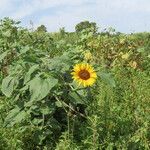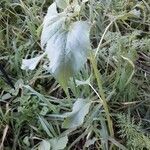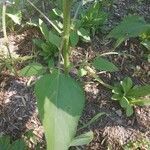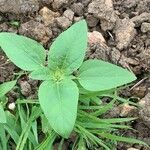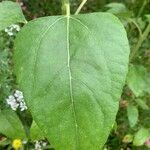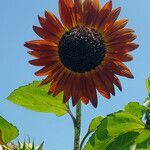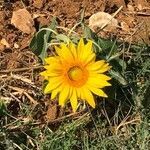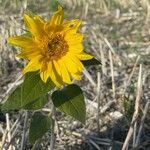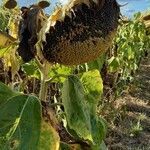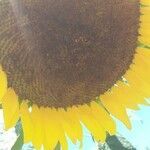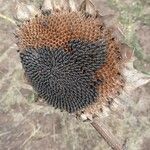Annuals, 100-300 cm. Stems erect, usually hispid. Leaves mostly cauline, mostly alternate; petiole 2-20 cm; blade ovate-lanceolate to ovate, 10-40 × 5-40 cm, abaxially usually ± hispid, sometimes gland-dotted, base cuneate to subcordate or cordate, margin serrate. Capitula 1-9; peduncles 2-20 cm; involucres hemispheric or broader, 15-40(-200) mm in diam.; phyllaries 20-30(-100), ovate to ovate-lanceolate, 13-25 × (3-)5-8 mm, abaxially usually hirsute to hispid, rarely glabrate or glabrous, usually gland-dotted, margin usually ciliate, apex abruptly narrowed, long acuminate; paleae 9-11 mm, 3-toothed, middle teeth long acuminate, glabrous or hispid. Ray florets (13-)17-30(-100+); lamina 25-50 mm. Disk florets 150-1000; corollas 5-8 mm, throats bulbous at bases, lobes usually reddish, sometimes yellow; anthers brownish to black, appendages yellow or dark. Achenes (3-)4-5(-15) mm, glabrate; pappus of 2 lanceolate scales 2-3.5 mm plus 0-4 obtuse scales 0.5-1 mm. Fl. Jul-Sep, fr. Aug-Oct. 2n = 34.
Erect annual or biennial herb with taproot, (0.2–) 0.6–1.5 (–2) m high; stems green, hispid. Leaves petiolate, broadly lanceolate or ovate to ±cordate, 3–20 cm long, 1–10 cm wide, entire or toothed; both surfaces hispid to scabrous; upper leaves alternate. Capitula terminal, 1 or few per plant, solitary, nodding, on hairy peduncles, usually (2.5–) 3–7 cm diam. (excluding rays) or 8–18 cm diam. (including rays); involucral bracts ovate to broadly lanceolate, abruptly long-acuminate, scabrous, ciliate; paleae long-awned with shorter deltoid lateral lobes, striate. Ray florets bright yellow; ligules 2–6 cm long. Disc florets numerous, brownish. Achenes obovate to subcuneate, 3-or 4-angled, 5–6 (–10) mm long, dark brown to black, sometimes with grey streaks or mottled, finely pubescent. Pappus scales 2, early caducous.
Annual herb, up to 4 m high; usually branching from base. Leaves alternate, sometimes opposite below; blade ovate to triangular, up to 100 x 60 mm, apex acuminate, base cordate to truncate and abruptly descending on petiole, margins dentate or denticulate, scabrid-pubescent on both surfaces; petiole up to ± 100 mm long. Heads radiate, generally 80-100 mm in diameter, sometimes larger, solitary on long peduncles terminating upper branches. Involucral bracts 3-seriate, ovate, usually > 4 mm wide, mostly abruptly long-acuminate, scabridulous. Receptacle with paleae enfolding disc florets. Flowers: ray florets neuter, yellow; disc florets bisexual, brownish or purplish black; Mar. Fruit with cypsela narrowly obovate, ± 5 mm long, somewhat compressed, thinly hispid. Pappus of 2 small scales, soon caducous.
Coarse, rough-hairy annual (0.5–)1–3 m; lvs chiefly alternate (except the lowermost), mostly toothed, long-petiolate, ovate or broader, at least the lower cordate in well developed plants; heads large, the red-purple (yellow) disk seldom under 3 cm wide; invol bracts ovate or ovate-oblong and abruptly narrowed above the middle to the acuminate tip, ciliate and with some rather long coarse hairs on the back; receptacle flat or nearly so, its bracts inconspicuously hairy at the tip; 2n=34. A weed in disturbed sites, especially in moist, low ground, throughout the U.S. and adj. Can. and Mex. July–Sept. Typical wild plants are branched, with several or many heads. Cult. forms, which readily escape, have solitary (or few), often much larger heads. (H. lenticularis; H. aridus)
Annual herb, ± 2 m high; branching from base. Leaves alternate, sometimes opposite below, ovate to triangular, base cordate to truncate and abruptly descending on petiole, apex acuminate, scabrid-pubescent on both surfaces. Capitula terminal, solitary, long-pedunculate; involucral bracts triseriate, ovate-lanceolate, abruptly long-acuminate, scabridulous. Ray florets neuter; corolla yellow, occasionally reddish, strap-shaped, conspicuous. Disc florets bisexual, fertile; corolla yellow or sometimes partly or wholly purple, narrowly tubular below, expanded above, 5-toothed. Anthers entire or minutely sagittate at base, with apical appendage. Style with branches narrowly oblong. Pappus of 2 deciduous awn-like scales. Cypselae narrowly obovate, ± compressed, thinly hispid.
Annual herb to 4 m, usually branching from the base. Leaves alternate, sometimes opposite below, lamina of upper leaves up to c. 10 x 6 cm, lower leaves often much larger, ovate to triangular, apex acuminate, base cordate to truncate and abruptly descending on the petiole, scabrid-pubescent on both surfaces, petiole up to c. 10 cm long. Heads generally 8-10 cm across the expanded rays but sometimes much larger, solitary on long peduncles terminating the upper branches. Involucral bracts triseriate, ovate-lanceolate, mostly abruptly long-acuminate, scabridulous. Rays yellow, disc brownish-or purplish-black. Achenes c. 5 mm long, narrowly obovate, somewhat compressed, thinly hispid, pappus of 2 small narrow scales, soon caducous.
Erect annual herb, with stout taproot. Stems scabrid, not branched, 0.4-c. 2 m tall. Lower and mid cauline lvs hispidulous, petiolate, ovate-elliptic to ovate-triangular, acute to acuminate, obtuse or truncate to cordate at base, serrate, 6-20-(30) cm long; upper cauline lvs similar to lower, but uppermost alternate, smaller and narrower. Capitula (8)-10-20-(30) cm diam., solitary. Involucral bracts in 2-3 rows, moderately to densely scabrescent, ciliate, ovate to ovate-triangular, aristate, c. 3-6 × (0.8)-1.5-2 cm. Receptacle ± flat; scales membranous, the larger with dark ciliate apices. Ray florets (15)-20-50; disc florets numerous, brownish yellow. Achenes oblong-obovoid, narrowed to base, hairy, 10-15 mm long; pappus 0.
Sunflower, originally from America, is cultivated in many places in East Africa for its seeds, as an oil crop. Occasionally it seems to escape and become naturalised, as in T 6, Uzaramo District: Dar es Salaam on airport road, Apr. 1977, Wingfield 3392a! and T 8, Songea District: Mkaku River SW of Kitai, Mar. 1956, Milne-Redhead & Taylor 9075!.. These escapes are small annual herbs, 20–120 cm high.. Leaves alternate, ovate, to 8 x 3.5 cm and scabridulous to the touch, petiolate.. Capitula terminal and solitary; ray florets ± 14, yellow, 35 x 10 mm; disc florets very many, yellow orange.. In cultivation the plant and all its parts may become much larger. Both the cited specimens came from road-sides.. Fig. 143 (page 707).
An upright annual plant. It varies in height from 1-4 m. It has a strong tap root. Plants are mostly unbranched but may have some branches. The stems are hairy. The leaves are large and oval to heart shaped. They have teeth around the edges. They are roughly hairy and mid to dark green. Leaves can be 10-40 cm long by 5-20 cm wide. The leaf stalk is long. The flowers are yellow and daisy like. Flowers are 9-20 cm across. Sometimes they are tinged red or purple.

